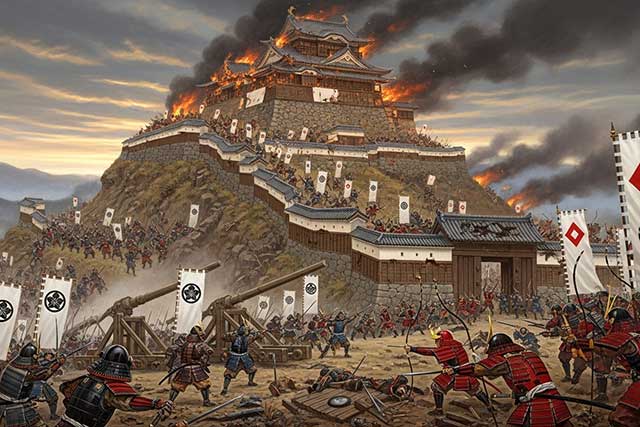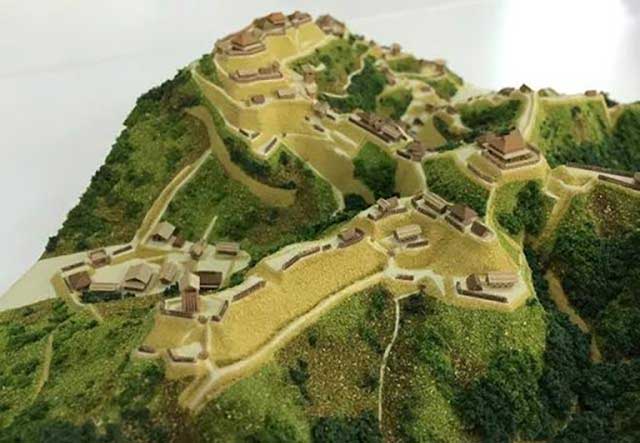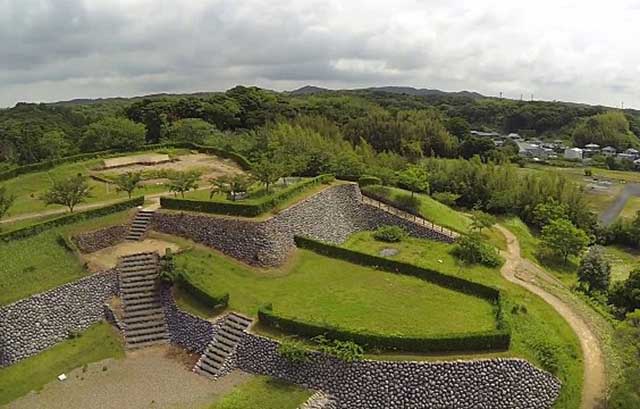
The history of the castle prior to the conflict between the Tokugawa and Takeda clans is rather unclear. According to one version, the castle was built in 1416, when Imagawa Sadayoshi (1325–1420) was governor of Suruga Province and half of Totomi Province. Allegedly, it was he who ordered Imagawa Norimasa (1364–1433) to build this fortification. However, no reliable evidence has been found to support this. Another version is considered more plausible, according to which the castle was built during the conquest of Totomi Province at the end of the 15th century by Imagawa Ujitsuna (1473–1526) and his general Ise Shinkuro (Hojo Soon). In this case, another of Ujitsuna's generals, Kusima Masashige (1492–1521), is considered responsible for the construction.
It is known for certain that Takatenjin Castle was rebuilt many times during its existence. There is even a theory that there were originally two castles built on neighbouring peaks of Mount Kakuo, which eventually merged into one large fortification. By 1580, it measured 1,500 metres from north to south and 1,000 metres from west to east. Takatenjin was considered one of the most impregnable castles of its time and served as an important outpost in the Totomi province.
After the Kusima clan, the castle passed to another vassal of the Imagawa clan, the Ogasawara clan. After the defeat of Imagawa by the armies of Oda and Tokugawa, the castle became the property of Ieyasu.

The first and second sieges
In 1571, Takeda Shingen laid siege to the castle with an army of 20,000, but failed and was forced to retreat. His son, Takeda Katsuyori, was successful during the second siege of Takatenjin Castle in 1574. The loss of this important strategic point greatly upset Ieyasu, and he waited for the right moment to retake the castle. In 1580, he decided that the time had come for revenge.
Preparations for the siege
The commander of Takatenjin at that time was Okabe Masayuki (Nagano), who had about a thousand men under his command. Masayuki had previously served the Imagawa clan, then Takeda Shingen, and after his death, his son, Takeda Katsuyori. He was an experienced and courageous commander.
Tokugawa's troops marched from Hamamatsu Castle and approached Takatenjin in October 1580. Ieyasu ordered the construction of a small fort on Mount Mitsuizan, located directly opposite the castle. Mitsuzan was ideal for building a fortification: there were three water sources there, and the steep slopes provided natural protection on all sides. The height of the hill allowed control of the enemy's actions in the castle and observation of the entire surrounding area.
Ieyasu had an excellent base for further operations against Okabe Masayuki, but he felt that this was not enough. He ordered the construction of about six more forts on the neighboring hills, surrounding the castle from the southeast, east, and northeast. Realizing how strong this castle was, Ieyasu prepared for a long siege.
His soldiers began to build a double ring of fortifications and dry moats around the castle. Piles of branches were piled up in front of the palisades to create additional obstacles. These fortifications served not only to prevent sorties by the besieged, but also to protect against possible attempts to unblock the castle from the outside. Ieyasu feared that Katsuyori might send troops to help.
The siege plan and the forces of the parties
Ieyasu set up his headquarters on Mamushizuka Hill, about eight kilometers from the castle. His total forces numbered about 11,000 men. Ieyasu himself commanded a detachment of 3,000, Honda Tadakatsu and Sakakibara Yasumasa commanded two and a half thousand each, Torii Mototada commanded one thousand, Osuka Yasutaka commanded seven hundred and fifty, Ishikawa Yasumichi and Honda Yasusige commanded five hundred each, and Sakai Shigetada commanded two hundred and fifty men.
Ieyasu ordered all the surrounding villages to be burned and the crops destroyed in order to deprive the castle of food. He chose the tactic of “attacking with hunger,” hoping to force the enemy to surrender through starvation. The defenders were also regularly fired upon with bows and guns. Tokugawa's archers took cover behind portable tate shields and bamboo taketaba bundles.
Ieyasu did not plan a frontal assault — he wanted to force the enemy to surrender. To prevent escapes and sudden sorties, sentries were placed along the perimeter at a distance of about 1.8 meters from each other.
The Siege
The New Year passed without change. In early January, word came that Takeda Katsuyori had sent troops to aid the castle. Upon learning of this, Oda Nobunaga also sent reinforcements from the province of Owari under the command of Mizuno Tadashige (1541–1600), stationing them at Yokosuka Castle near the besieged Takatenjin.
However, this news turned out to be false—Katsuyori did not send troops, and the garrison was left without support.
In February, spies reported to Ieyasu that famine had begun in the castle and the defenders were eating grass and leaves. According to some sources, Ieyasu offered them surrender, promising to spare their lives, but there is no reliable confirmation of this. In any case, if the offer was made, the garrison rejected it, and soon everything ended in a bloody assault.
The final battle
In March 1581, Ieyasu began preparations for the final offensive, counting on the enemy being exhausted and weakened. He moved his headquarters to Yokosuka Castle and directed the preparations from there.
On March 22, 1581, the final battle took place. Sources differ in the details, but it appears that the garrison decided on a desperate sortie. According to the Shintō Kōki chronicle, all 688 remaining defenders of the castle rushed into the attack and were completely destroyed by Tokugawa's superior forces. Ietada Nikki's diary records: “We lost about 130 fighters, while the enemy lost more than 600.” Other sources specify that the defenders divided into two groups: one headed west and engaged in battle with Okuba Tadayo, while the other headed east, where they were met by Ishikawa Yasumichi. Both groups were completely destroyed.
There were rumors that some managed to break through the siege. Among the survivors was mentioned the deputy commander, Yokoshi Tadatoshi.
Consequences
After the defeat of the besieged, Ieyasu ordered a search of the area for fugitives. He himself entered the captured castle and soon ordered the troops to withdraw. On March 24, he returned to Hamamatsu.
The captured Takatenjin was used for some time as an auxiliary castle in the Totomi province, but after Ieyasu moved to the Kanto region in 1590, it was abandoned. Only ruins remain to this day.

See also
-
The Siege of Hara Castle

The Shimabara Rebellion of 1637–1638, which culminated in the siege of Hara Castle, was the last major uprising of the Edo period and had serious political consequences.
-
Battle of Tennoji

The confrontation between Tokugawa Ieyasu and Toyotomi Hideyori during the “Osaka Winter Campaign” ended with the signing of a peace treaty. On January 22, 1615, the day after the treaty was signed, Ieyasu pretended to disband his army. In reality, this meant that the Shimazu forces withdrew to the nearest port. On the same day, almost the entire Tokugawa army began filling in the outer moat.
-
Siege of Shuri Castle

The Ryukyu Kingdom was established in 1429 on Okinawa, the largest island of the Ryukyu (Nansei) archipelago, as a result of the military unification of three rival kingdoms. In the following years, the state's control spread to all the islands of the archipelago.
-
The Siege of Fushimi Castle

Fushimi can perhaps be considered one of the most “unfortunate” castles of the Sengoku Jidai period. The original castle was built by Toyotomi Hideyoshi in the southeast of Kyoto in 1594 as his residence in the imperial city.
-
The Siege of Otsu Castle

The siege of Otsu Castle was part of the Sekigahara campaign, during which the so-called Eastern Coalition, led by Tokugawa Ieyasu, fought against the Western Coalition, led by Ishida Mitsunari. Otsu Castle was built in 1586 by order of Toyotomi Hideyoshi near the capital Kyoto, on the site of the dismantled Sakamoto Castle. It belonged to the type of “water castles” — mizujō — as one side of it faced Japan's largest lake, Lake Biwa, and it was surrounded by a system of moats filled with lake water, which made the fortress resemble an island.
-
The Siege of Shiroishi Castle

The siege of Shiroishi Castle was part of the Sekigahara campaign and took place several months before the decisive battle of Sekigahara. The daimyo of Aizu Province, Uesugi Kagekatsu, posed a serious threat to Tokugawa Ieyasu's plans to defeat the Western Coalition, and Ieyasu decided to curb his actions with the help of his northern vassals. To this end, he ordered Date Masamune to invade the province of Aizu and capture Shiroishi Castle.
-
The Second Siege of Jinju Castle

During the two Korean campaigns of the 16th century, the Japanese repeatedly had to capture enemy fortresses and defend occupied or constructed fortifications from the combined Korean and Chinese forces. Among all the operations of that time, the second siege of Jinju Castle is considered the most interesting from the point of view of siege warfare.
-
The Siege of Takamatsu Castle

The siege of Takamatsu Castle in Bitchu Province is considered the first mizuzeme, or “water siege,” in Japanese history. Until then, such an original tactic had never been used.

